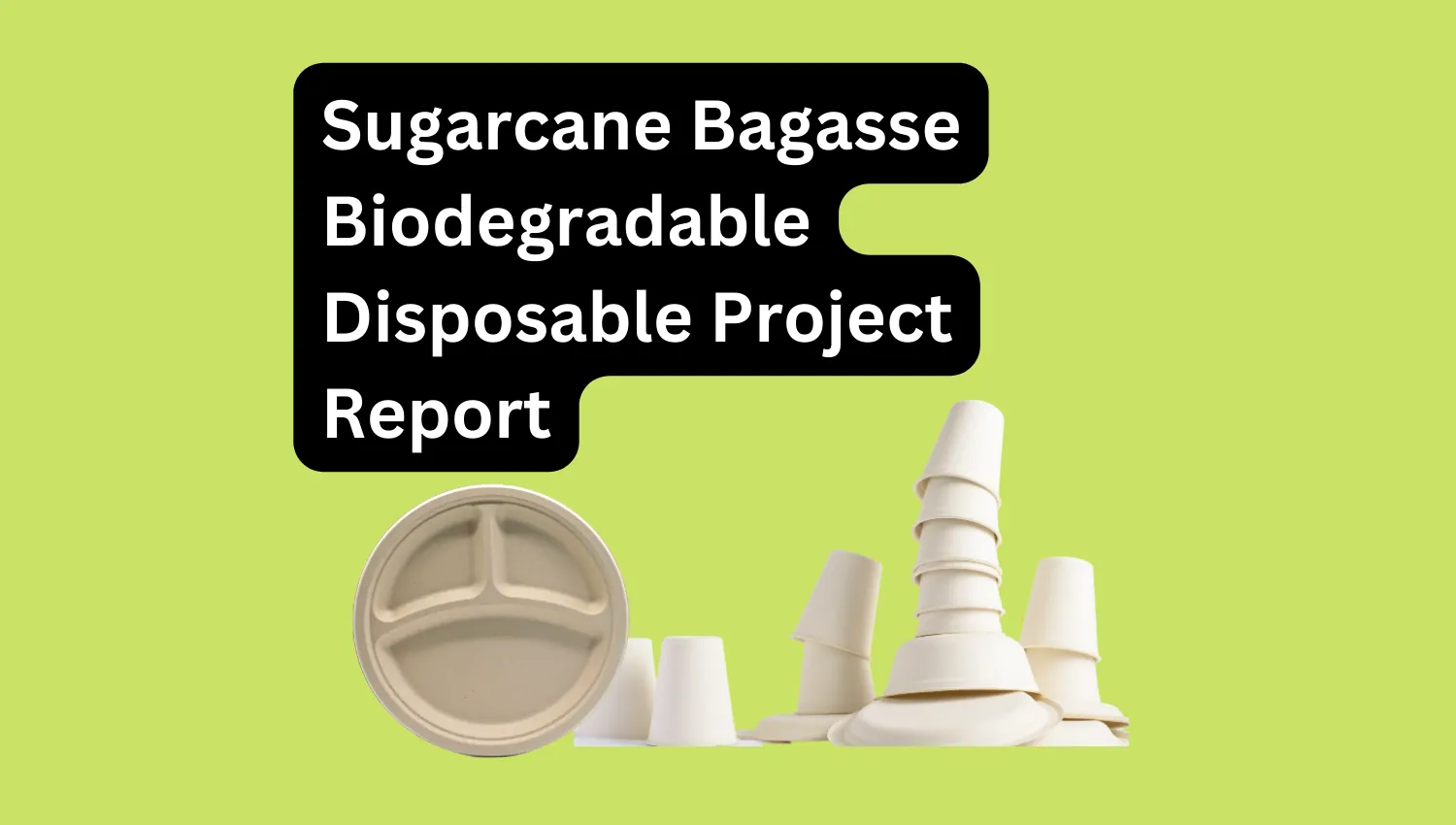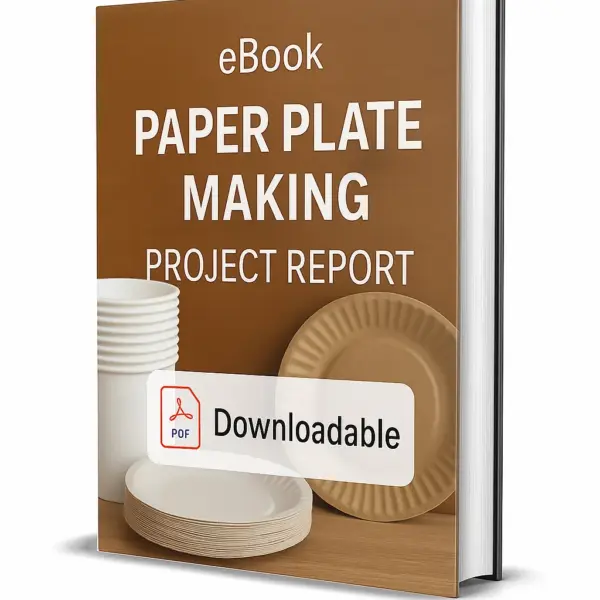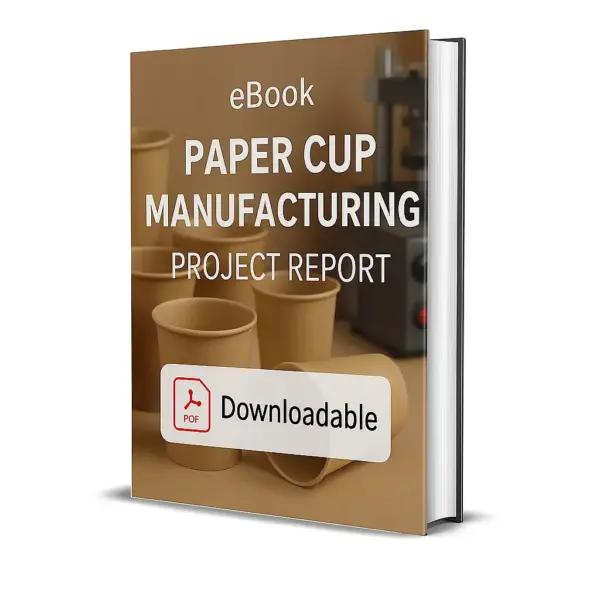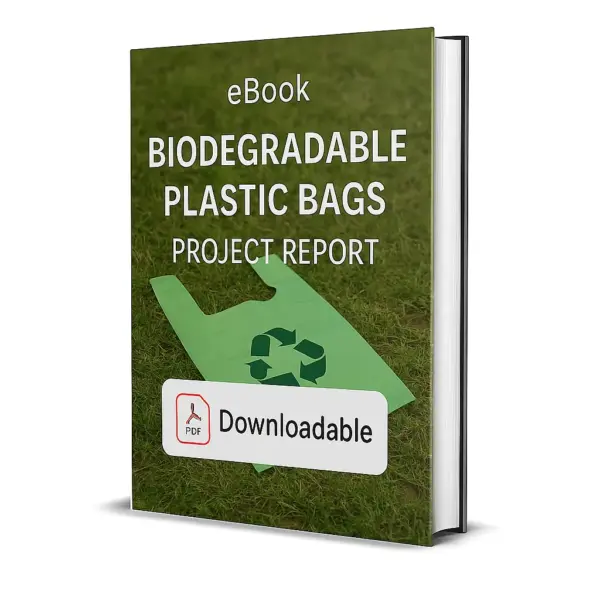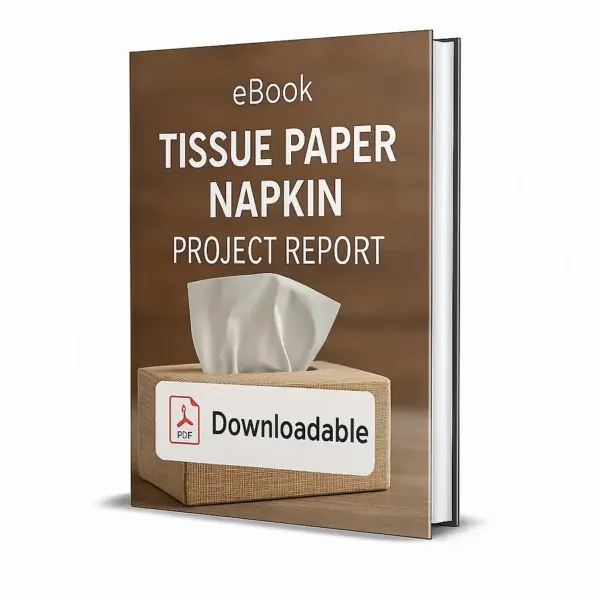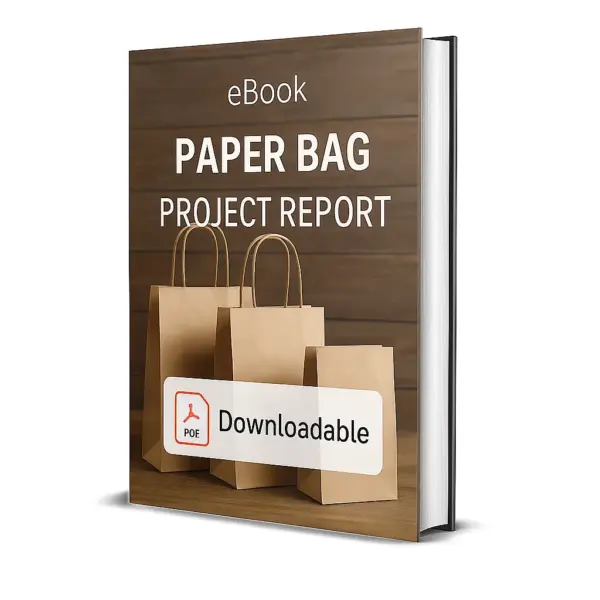Sugarcane Bagasse Biodegradable Disposable Tableware manufacturing business is a highly lucrative and profitable start-up that can help you yield high profits. You can also get support from the government in the form of subsidies and schemes. Sugarcane bagasse is a material commonly used to manufacture biodegradable disposable tableware such as plates, bowls, cups, and cutlery. It is an eco-friendly alternative to traditional plastic and paper tableware, as it is made from renewable and sustainable resources.
Bagasse is a by-product of sugarcane juice extraction and is commonly considered waste, but with advances in processing technology, it can be transformed into a versatile and durable material for tableware products. Biodegradable disposable tableware made from sugarcane bagasse is compostable, reducing the environmental impact of single-use tableware. Additionally, the production process of sugarcane bagasse tableware generates less greenhouse gas emissions compared to traditional plastic and paper products, making it a more sustainable option for consumers and businesses. Biodegradable cup-making is a very lucrative business along with a biodegradable plate-making set-up. These products have huge market demand.
Sugarcane Bagasse Tableware Project Report
We are a team of experts who work on all business prospects. Sugarcane Bagasse Tableware detailed project report (DPR) is prepared after a deep analysis of this business prospect. Based on deep research and rich pictorial and graphical view, contains significant information that can fulfil the need for financial assistance from investors banks or government-sponsored schemes.
Our data is up to date, made by chartered accountants, and it can help you impress your money lenders. Project reports on our website are extraordinary and have unbeatable quality for thousands of people to trust.
You can get every micro detail to its utmost accurate level of calculation as per the guidelines of financial institutions. These project reports are accepted by all banks, nonbanking financial institutions, government departments, etc. You can easily access these neat, readable, straightforward forward, and honest descriptions. The Business Plan is well-spaced with titles and subtitles and is error-free.
Our experts make sure that the reports are precise and offer maximum information to buyers with minimum words. You can use it as a road map for all decision-making reasons whenever you require. The banks always ask for project reports before they decide to lend you a business loan. It is crucial to have this significant document that is written in simple language and understandable form so that you can get a real insight into this business idea.
Characteristics of Sugarcane Bagasse Products
Bagasse products have several key characteristics, including:
- Renewable resource: Bagasse is a byproduct of sugarcane production, making it a renewable resource.
- Biodegradable and compostable: Bagasse products break down into natural substances, reducing their environmental impact.
- Lightweight: Bagasse products are lightweight, making them easy to transport and handle.
- Moisture resistant: Bagasse products are moisture resistant, making them suitable for holding wet foods.
- Microwave safe: Many bagasse products are microwave safe, making them convenient for heating food.
- Strong and durable: Despite being lightweight, bagasse products are strong and durable enough to hold heavier foods and liquids.
Benefits Of Using Bagasse Products
There are several benefits of using bagasse products:
- Sustainable: Bagasse is a byproduct of sugarcane production, making it a renewable resource.
- Biodegradable: Bagasse products are biodegradable and compostable, reducing the environmental impact of waste. Biodegradable plate manufacture is becoming the need of the hour.
- Cost-effective: Bagasse products are often less expensive than traditional plastic or foam products.
- Safe: Bagasse products are safe for food contact and do not contain any harmful chemicals.
- Versatile: Bagasse products can be made into a wide range of products, including plates, bowls, cutlery, and food containers.
- Durable: Bagasse products can be used multiple times and are strong enough to hold heavier foods and liquids.
- Better for the environment: Using bagasse products instead of single-use plastics can reduce the amount of plastic waste in landfills and oceans.
Market Prospects For Starting Sugarcane Bagasse Tableware Manufacturing Business In India
Sugarcane bagasse-based disposable utensils are environmentally friendly alternatives to traditional plastic utensils, and there are several market prospects for this type of business. Here are a few:
- Growing demand for eco-friendly products: With increasing awareness of environmental issues, consumers are becoming more conscious of their choices and are increasingly opting for products that are more environmentally friendly. This is driving demand for sugarcane bagasse-based disposable utensils, which are biodegradable and compostable.
- Rising concerns about plastic waste: Plastic waste is a growing problem, and there is increasing public pressure to reduce its use. This presents an opportunity for businesses to offer alternative products such as sugarcane bagasse-based disposable utensils.
- Growing food and beverage industry: The food and beverage industry is a major consumer of disposable utensils, and it is expected to continue growing in the coming years. This growth presents a significant opportunity for businesses offering sugarcane bagasse-based disposable utensils.
- Government regulations: Governments around the world are implementing regulations to reduce plastic waste, which could lead to an increase in demand for alternatives such as sugarcane bagasse-based disposable utensils.
- Cost competitiveness: While sugarcane bagasse-based disposable utensils may be slightly more expensive than traditional plastic utensils, they are becoming more cost-competitive as production processes are optimized and economies of scale are achieved.
However, businesses should be aware of the competition and keep their products high-quality and cost-effective to succeed. You can get all the significant information about the bagasse tableware business in the bagasse tableware project report for bank loans on our website.
Raw Materials Needed To Make Sugarcane Bagasse Biodegradable Disposable Tableware
The most ideal resource for creating an environment-friendly disposable utensil would be that which is both biodegradable and compostable and on that, there are very limited options available, as mentioned earlier, except for basic natural resources i.e. leaves, etc, wheat straw, bamboo, and sugarcane bagasse are the primary resources that are both biodegradable and compostable. Out of these, sugarcane bagasse is the most promising due to the factors stated herewith.
Sugarcane bagasse is a by-product of sugarcane production that has gained attention as a renewable energy source. It is the fibrous residue left over after the juice extraction process and is usually discarded. However, bagasse can be burned to generate steam and electricity, making it a potentially valuable resource for sugarcane mills.
Bagasse is a form of biofuel, meaning it is derived from organic matter and is considered to be a sustainable energy source. The process of burning bagasse to generate electricity is considered carbon neutral, as the carbon dioxide released from the burning process was previously absorbed by the sugarcane plant during photosynthesis.
In addition to its use as a biofuel, bagasse can also be processed into a range of other products. For example, it can be used as a raw material in the production of paper products, animal feed, and building materials such as particle board and insulation. The use of bagasse in these applications can help to reduce the waste generated by the sugarcane industry and promote sustainability.
However, the use of bagasse as a source of energy is not without challenges. One issue is that bagasse is not consistently available throughout the year, as its availability depends on the sugarcane harvest. Additionally, the energy yield from bagasse is dependent on the efficiency of the burning process, and there can be significant variation in the quality and composition of bagasse from different sugarcane varieties and growing conditions.
Sugarcane bagasse has the potential to play an important role in meeting the world’s energy needs, especially in regions where sugarcane is widely cultivated. With continued research and development, the potential of bagasse will likely be realized and it will become an increasingly important renewable energy source in the future.
How Do I Manufacture Bagasse Products?
Manufacturing Process of Bagasse Products
The manufacturing process of bagasse products typically involves the following steps:
- Collection: Sugar cane stalks are harvested, and the juice is extracted to make sugar. The remaining fibrous material, called bagasse, is collected.
- Pulping: The collected bagasse is processed through a pulping machine to separate the fibres from any impurities.
- Drying: The pulped bagasse is dried to a specific moisture content.
- Compression: The dried bagasse is then compressed into a mould to form the desired shape. The compression process may be done using heat and pressure or a mechanical press.
- Finishing: The compressed bagasse products are then trimmed and smoothed to their final shape and size.
- Decoration: Some bagasse products may be printed with designs or logos using food-grade ink.
- Packaging: The finished bagasse products are then packaged for shipment and distribution.
How Do I Start Sugarcane Bagasse Disposable Utensils Manufacturing Business In India?
Sugar cane bagasse-based utensils are eco-friendly, biodegradable, and compostable alternatives to traditional plastic utensils. To set up a business producing these utensils, you need to consider the following requirements:
- Business Plan: Develop a detailed business plan that outlines your objectives, target market, marketing strategy, production plan, financial projections, and operating procedures.
- Raw Materials: Sugar cane bagasse is the main raw material for producing utensils. You will need to secure a reliable and cost-effective source of bagasse to ensure a steady supply of raw materials.
- Equipment: Depending on the scale of your business, you may need to purchase or lease equipment such as a pulping machine, molding machine, and drying equipment. You may also need to invest in additional equipment such as cutting and packaging machines.
- Labour: You will need to hire skilled workers who can operate the machinery, mold and shape the utensils, and handle the packaging and distribution processes.
- Manufacturing Space: You will need a suitable manufacturing space that is equipped with adequate electricity and water supply, ventilation, and fire safety systems.
- Quality Control: Establish a quality control process to ensure that your products meet the standards set by industry and regulatory bodies. This may involve investing in testing equipment and implementing a quality management system.
- Certification: Obtain certifications such as FDA, BPI, and composting certifications that demonstrate the quality and sustainability of your products.
- Marketing and Sales: Develop a marketing and sales strategy that targets distributors, wholesalers, and end-users. Utilize digital marketing channels such as social media, e-commerce platforms, and email marketing to reach a wider audience.
- Legal Requirements: Comply with local and national regulations regarding the production, labelling, and distribution of your products. This may include obtaining licenses, permits, and insurance coverage.
- Financing: Securing the necessary financing to fund your business operations, purchase equipment, and raw materials, and pay for labor and marketing expenses. Consider alternative financing options such as loans, grants, and crowdfunding.
In Sum-up, the growth of eco-conscious consumers and demand for environmentally friendly products presents a significant opportunity for businesses in this market.
How Much Money Do I Need To Invest For Starting Sugarcane Bagasse Products Business In India?
The cost of starting a sugarcane bagasse-based utensil business can vary depending on the location, scale of production, and equipment requirements. However, a rough estimate of the costs involved is as follows:
- Equipment: The cost of purchasing or leasing pulping machines, molding machines, cutting machines, and packaging equipment can range from ₹500,000 to ₹10,000,000 or more.
- Raw Materials: The cost of sugar cane bagasse will vary depending on the location and the source of supply. The cost can range from ₹30 to ₹150 per kilogram.
- Manufacturing Space: The cost of renting or leasing a suitable manufacturing space will depend on the location and size of the facility. This can range from ₹10,000 to ₹100,000 or more per month.
- Labour: The cost of hiring workers will depend on the minimum wage laws in your area and the number of employees required. This can range from ₹500,000 to ₹2,500,000 or more per year.
- Marketing and Sales: Marketing and sales expenses such as digital marketing, trade show participation, and sales personnel salaries can range from ₹500,000 to ₹2,500,000 or more per year.
- Legal and Certification: The cost of obtaining licenses, permits, and certifications such as FDA, BPI, and composting certifications can range from ₹50,000 to ₹200,000 or more.
It is important to keep in mind that these are rough estimates and the actual cost of starting a sugarcane bagasse-based utensil business in India can vary significantly based on specific circumstances. Additionally, the cost of financing may also need to be taken into account when determining the total investment required to start this business. You can get the exact figures for starting your own sugarcane bagasse biodegradable disposable tableware business in the customized project report.
How Much Space Do I Need To Start Sugarcane Bagasse Biodegradable Disposable Tableware in India?
The area needed for the sugarcane bagasse-based utensils business will depend on the scale of production and the type of equipment used. However, a rough estimate of the minimum space requirement is as follows:
- Manufacturing Space: The manufacturing space will depend on the size of the pulping machines, molding machines, cutting machines, and packaging equipment. A small-scale production facility can require anywhere from 500 sq. ft. to 5,000 sq. ft. or more.
- Raw Material Storage: Sugar cane bagasse is usually stored in a separate room or warehouse before being processed. The storage space required will depend on the amount of raw material being stored and the size of the storage containers.
- Equipment Space: Pulping machines, molding machines, cutting machines, and packaging equipment will require a separate space for installation and operation. The size of this space will depend on the size and type of equipment being used.
- Office Space: A separate office space will be required for administration, accounting, and other office functions. The size of this space will depend on the number of employees and the type of office equipment being used.
- Parking Space: Adequate parking space will be required for employees and visitors, as well as for delivery trucks and other vehicles.
- Access to Utilities: The manufacturing facility will require access to water, electricity, and drainage facilities.
- Waste Management: A separate space will be required for the storage and disposal of waste generated during the manufacturing process.
Equipment and Machinery Needed To Manufacture Sugarcane Bagasse Utensils
The machinery required for a sugarcane bagasse-based disposable utensils business will depend on the specific product range being manufactured and the desired production capacity. Some of the essential machinery and equipment required are:
- Extruder: To produce sugarcane bagasse-based disposable utensils, an extruder machine is required to process the raw material and make it into a usable form.
- Molds: Moulds are used to give the desired shape to the extruded material. Molds come in various sizes and shapes depending on the type of product being produced.
- Cutting machine: This machine is used to cut the extruded material into the desired shape and size.
- Punching machine: This machine is used to create holes in the products for air ventilation.
- Printing machine: This machine is used for printing logos, designs, or other details on disposable utensils.
- Packaging machine: Packaging machines are used to pack the finished products into appropriate packaging materials.
- Quality control equipment: To ensure the quality of the products, it is essential to have quality control equipment such as tensile strength testers, hardness testers, and thickness gauges.
The cost of these machines can vary depending on their specifications and the production capacity required. It is recommended to purchase machinery from a reputable manufacturer to ensure quality and durability.
It is also important to consider the labour and operational costs, including the cost of maintenance, spare parts, and personnel training.
Licenses and Permits Needed to Start Sugarcane Bagasse Biodegradable Disposable Tableware In India
Starting an eco-conscious utensils business in India requires obtaining several licenses and permits from various government agencies. The specific requirements will vary based on the location of the business and the type of products being manufactured. However, some of the common licenses and permits required are:
- Business Registration: To start a business in India, it must be registered with the Registrar of Companies (ROC). The process of registering a business in India typically involves obtaining a Digital Signature Certificate (DSC), and a Director Identification Number (DIN), and filing the necessary forms with the ROC.
- Trade License: A trade license is a permit issued by the local municipal corporation to conduct business activities within a specified area. A trade license is necessary to operate a business legally.
- GST Registration: All businesses with an annual turnover of more than 20 lakhs (INR) are required to register for Goods and Services Tax (GST) in India. GST registration is mandatory for businesses to be able to collect and pay taxes.
- FSSAI License: The Food Safety and Standards Authority of India (FSSAI) is the primary agency responsible for regulating the food industry in India. All food businesses, including sugarcane bagasse-based utensils, must obtain an FSSAI license to operate legally.
- Environmental Clearance: Businesses involved in the manufacturing of products may require environmental clearance from the Ministry of Environment, Forests and Climate Change (MOEFCC) to ensure that their operations do not harm the environment.
- Factory License: A factory license is required to set up a manufacturing unit. This license is issued by the local state pollution control board and certifies that the factory complies with environmental regulations.
- Labor Licenses: All businesses in India are required to comply with labour laws, including the payment of minimum wages, employee benefits, and social security. Businesses must obtain licenses from the appropriate government agencies to demonstrate compliance.
In addition to the above licenses, businesses may also be required to obtain additional permits, such as fire safety certificates, building permits, and electricity connections, depending on the specific requirements of their location.
It is important to note that the process of obtaining licenses and permits in India can be time-consuming and complicated. It is recommended to seek the assistance of a professional, such as a lawyer or consultant, to ensure that all the necessary licenses and permits are obtained in a timely and efficient manner.
Marketing Strategy To Promote Sugarcane Bagasse Disposable Tableware Business In India
Marketing plays a crucial role in the success of any business, and eco-friendly utensils-making business is no exception. Here are some marketing strategies that can be used to promote the business and reach potential customers:
- Social Media Marketing: Utilize social media platforms such as Facebook, Instagram, and Twitter to create a strong online presence, showcase the product line, and engage with potential customers.
- Content Marketing: Create and distribute relevant, educational, and informative content (such as blog posts, infographics, and videos) that highlights the benefits of using eco-friendly utensils and the environmental impact of traditional utensils.
- Influencer Marketing: Partner with influencers in the eco-conscious community to promote the product and reach a wider audience.
- Trade Shows and Events: Participate in trade shows and events related to eco-friendliness, sustainability, and food service to showcase the product line and connect with potential customers.
- Email Marketing: Use email marketing to keep customers informed about new products, promotions, and events related to the business.
- Product Sampling: Offer product samples to customers and encourage them to try the product and share their experiences with others.
- Public Relations: Leverage public relations to generate media coverage and increase brand awareness. This can be achieved by submitting press releases, arranging interviews with media outlets, and pitching story ideas to journalists.
- Sustainable Packaging: Utilize sustainable packaging to attract eco-conscious customers and promote the business’s commitment to sustainability.
It is also important to consistently communicate the business’s eco-friendly values and mission to attract customers who are conscious of their impact on the environment.
A comprehensive marketing strategy can help the business reach potential customers and achieve its goals. Utilizing a combination of online and offline marketing tactics can increase brand awareness and drive sales.
How to make sugarcane bagasse plates?
Making sugarcane bagasse plates involves the following steps:
- Collection of sugarcane bagasse
- Pulping the bagasse to create a slurry
- Molding the slurry into plates using a manual or automated process
- Drying and hardening the plates
- Sanding and smoothing the plates for a smooth surface
- Quality control checks to ensure the plates meet standards for strength, durability, and food safety.
The entire process should be carried out with sustainable and eco-friendly methods to ensure the end product is environmentally friendly. The sugarcane bagasse plates project report can assist you with all the required information.
How to make pulp from sugarcane bagasse?
To make pulp from sugarcane bagasse, the following steps are followed:
- Collection of sugarcane bagasse
- Grinding the bagasse into smaller pieces
- Mixing the ground bagasse with water to create a slurry
- Cooking the slurry to break down the fibres and form a homogenous mixture
- Screening the mixture to remove impurities and ensure uniform consistency
- Drying the final product, sugarcane bagasse pulp, for storage.
The process may vary based on specific requirements and equipment, but these are the general steps for making pulp from sugarcane bagasse.
How to start a sugarcane bagasse biodegradable product business?
To start a sugarcane bagasse biodegradable product business, you need to:
- Undertake market research and prepare a business plan.
- Secure funding.
- Obtain necessary licenses and permits.
- Source sugarcane bagasse and equipment.
- Establish production and hire employees.
- Market and promote products.
- Continuously monitor and evaluate business operations.
How has the Biodegradable Disposable Cups and Plates Manufacturing industry performed so far and how will it perform in the coming years?
The biodegradable disposable cups and plates manufacturing industry has experienced significant growth in recent years, driven by increasing consumer awareness and demand for more environmentally sustainable products. The industry has benefited from the growing trend toward reducing single-use plastic waste and the negative impact it has on the environment.
As a result of this trend, the biodegradable disposable cups and plates manufacturing industry has seen increased investment in research and development, leading to new and improved products with better performance and sustainability.
Looking ahead, the biodegradable disposable cups and plates manufacturing industry is expected to continue to grow as consumers continue to seek out eco-friendly products. Governments and organizations are also increasingly implementing policies and regulations aimed at reducing plastic waste, which will further drive growth in the industry.
Additionally, advancements in technology and production processes are likely to lead to lower production costs and improved product performance, further boosting the growth of the industry.
Overall, the outlook for the biodegradable disposable cups and plates manufacturing industry is positive, with strong growth expected in the coming years.
What is the Project Feasibility of Biodegradable Disposable Cups and Plates Manufacturing Plant?
The feasibility of a biodegradable disposable cups and plates manufacturing plant depends on various factors including market demand, competition, raw material availability, production process, cost structure, regulation, and financial viability. A comprehensive feasibility study should be conducted to assess these factors and determine the potential demand for the products, competition in the market, the availability and cost of raw materials, the efficiency and cost-effectiveness of the production process, compliance with regulations, and the financial viability of the project through a projected income statement, balance sheet, and cash flow statement.
Reasons For Buying Our Project Report
- Comprehensive research: Our business project reports are the result of extensive research, providing you with accurate and up-to-date information on the industry and market. This can help you make informed business decisions, as you’ll have a deep understanding of the market you’re entering.
- Industry insights: Our reports provide valuable insights into various industries, giving you a comprehensive understanding of the industry landscape. This includes information on the current market trends, market size, and key players in the industry.
- Market analysis: Our reports include a thorough analysis of the market, including market trends, competitor analysis, and growth opportunities. This can help you identify potential challenges and opportunities for your business and make informed decisions.
- SWOT analysis: Our reports include a SWOT analysis of your business, highlighting its strengths, weaknesses, opportunities, and threats. This can help you understand your business’s position in the market and identify areas for improvement.
- Financial projections: Our reports include financial projections, helping you understand the financial viability of your business and make informed decisions. The financial projections can also help you plan your budget and allocate resources effectively.
- Expert advice: Our reports are created by experienced industry professionals, providing you with expert advice and recommendations. These professionals can help you make informed decisions by offering their expertise and knowledge of the industry.
- Save time: Our reports save you time and effort by providing you with comprehensive information in one place, rather than having to gather information from multiple sources. This can help you make decisions faster and more efficiently.
- Save money: By investing in a comprehensive business project report, you can save money in the long run by avoiding costly mistakes and making informed decisions. This can help you avoid costly mistakes and make decisions that benefit your business in the long term.
- Tailored to your needs: Our reports can be tailored to meet your specific needs, ensuring that you receive the information and insights that are most relevant to your business. This can help you make decisions that are best suited to your business’s unique needs and goals.
Major Queries Answered In The Sugarcane Bagasse Biodegradable Disposable Tableware Project Report
We know you might have a lot of queries before or while planning to start a sugarcane bagasse products manufacturing business in India. We have listed all the answers to all your queries that might relate to set-up, location, financial investments, bank loan formalities and a lot more. You are very close to getting one. Simply order us to make one for you.
Project Report Format
In our project report format, we cover all technology details, flow charts and diagrams. You can explore them as and when required or deemed fit to include. We can also assist you in preparing in-depth financial calculations including CMA that are necessary for investors/banks.
Frequently Asked Questions On Sugarcane Bagasse Biodegradable Disposable Tableware Project Report
What is the requirement of utilities and overheads for setting up Biodegradable Disposable Cups and Plates Manufacturing plant?
The requirements of utilities and overheads for setting up a biodegradable disposable cups and plates manufacturing plant include electricity, water, natural gas, and other essential services such as waste management and internet connectivity. In addition to utilities, there will be other overhead costs such as rent, insurance, taxes, and maintenance expenses. It is important to accurately estimate these costs as they can significantly impact the overall viability of the project. It is also important to have contingency plans in place to address unexpected increases in utility and overhead costs. To minimize these costs, it is recommended to adopt energy-efficient technologies and negotiate favourable terms with utility providers. A thorough understanding of the local business environment, regulations, and market conditions are also necessary to ensure that the project is financially feasible and sustainable in the long term.
What are the Personnel (Manpower) Requirements for Setting up Biodegradable Disposable Cups and Plates Manufacturing Business?
The personnel (manpower) requirements for setting up a biodegradable disposable cups and plates manufacturing business include skilled and unskilled workers, managers, and administrative staff. Skilled workers are required to operate and maintain the manufacturing equipment, while unskilled workers are needed for manual labour such as packaging and stacking products. Managers are responsible for overseeing the operations, financial performance, and growth of the business, while administrative staff handles tasks such as customer service, bookkeeping, and regulatory compliance. It is important to determine the exact personnel requirements based on the size, scale, and nature of the business. A human resource plan should also be developed to ensure that the personnel are adequately trained, motivated, and managed. Hiring, training, and retaining qualified personnel is crucial for the success and growth of the business and should be given due consideration during the planning and implementation phases of the project.
What are the requirements of raw materials for setting up a Biodegradable Disposable Cups and Plates Manufacturing plant?
The requirements of raw materials for setting up a biodegradable disposable cups and plates manufacturing plant mainly include biodegradable materials such as sugarcane bagasse or corn starch. Other materials that may be required include additives and colourants to enhance the properties of the finished product. It is important to source high-quality raw materials to ensure the production of durable and reliable biodegradable disposable cups and plates. It is also important to have a reliable supply chain in place to ensure a steady flow of raw materials to the manufacturing plant. It is recommended to research and compare different suppliers and materials to find the best options for the specific requirements of the project.
What is the structure of the Biodegradable Disposable Cups and Plates Manufacturing Business and who are the key/major players?
The biodegradable disposable cups and plates manufacturing business is structured as a manufacturing operation that produces environmentally friendly disposable tableware products made from biodegradable materials such as sugarcane bagasse or corn starch. The key players in this industry include both large multinational corporations and small, locally-owned businesses. The major players in the market are focused on producing high-quality, cost-effective products while also striving to reduce their environmental impact. Companies that have a strong reputation for sustainability and eco-friendliness often enjoy a competitive advantage in the market. Additionally, there are also suppliers of raw materials and manufacturers of machinery and equipment that play a key role in the success of the industry. Bagasse-based tableware products include plates containers cups project reports that you can get in a gist of time from us.
Who are the Suppliers and Manufacturers of plants & Machinery for setting up Biodegradable Disposable Cups and Plates Manufacturing plants?
The suppliers and manufacturers of plants and machinery for setting up a biodegradable disposable cups and plates manufacturing plant can be found both locally and globally. Locally, there may be small-scale machinery manufacturers and suppliers that specialize in producing equipment for this type of industry. Globally, several multinational companies manufacture and supply the necessary equipment and machinery. Some examples include Gowlings Engineering, BOPP (Biaxially Oriented Polypropylene) Films, and Brentwood Industries. It is important to research and compare the options available to ensure that the equipment selected meets the specific requirements of the manufacturing process and is of good quality and cost-effective. It is also recommended to consult with an industry expert or a machinery supplier to get advice on the best equipment for the project.
How to write a detailed project report on bagasse-based products?
It is not at all an easy task to write a detailed project report on sugarcane bagasse products as you need to do deep market research and find out information like demand for these products in your location, then shortlist the products with more demand. Not just this, you need to explore the market deeply and find out raw material suppliers and ready stock transport modes. Your target audience is crucial because you must know the right market where you would sell the finished goods. The most important is to arrange finance to set up your plant. You need money that you cannot avail without the project report. You can henceforth contact us to get a detailed project report that contains all the required information with complete facts and figures.
Where can I get bagasse-based products CMA Data for a Bank Loan?
The bagasse-based products CMA Data for bank loans is available for download on our website. You can contact us and get more details about your queries.
